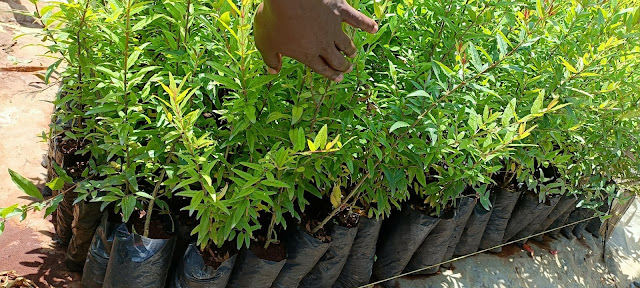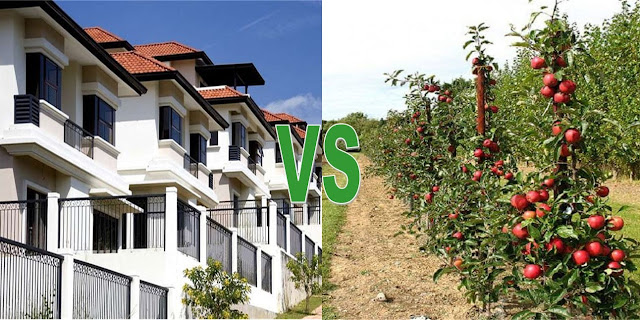Pomegranate farming in Kenya is now becoming popular, most farmers attracted mostly by the potential returns: pomegranate is one of the most expensive fruits in Kenya at the moment. However, a growing awareness on the health benefits of pomegranate among Kenyans is also playing an important role in the uptake of its cultivation by even small scale farmers.
 |
| Pomegranate farming in Kenya: A rising trend in agribusiness |
Pomegranate, scientifically known as Punica Granatum belongs to the Lythraceae family and has been grown for centuries in various parts of the world, especially Asia. Iran and India are the leading producers of the fruit worldwide. In Africa, Egypt is the largest producer of pomegranates which are an important income earner in the country's agricultural industry.
Why is Pomegranate farming in Kenya growing so fast?
Pomegranates are known for their vibrant red colour, unique flavour and numerous health benefits. In recent years, the demand for pomegranates in Kenya and the world over has significantly increased due to their rising popularity as a superfood. As a result, pomegranate farming has become an attractive industry for many farmers globally, Kenya not being left behind.
Climatic requirements for pomegranate farming
One of the main advantages of pomegranate farming is the plant's ability to thrive in diverse climatic conditions. Pomegranate trees are relatively tolerant to cold and hot temperatures, making them adaptable to various regions.
 |
| Pomegranate farming in Embu |
In Kenya, pomegranates perform well in areas that experience warm to hot climates such as such as Machakos, Makueni, Kitui, North-eastern Kenya, warmer parts of Rift Valley such as Laikipia, parts of Central Kenya such as Nyeri, the coastal region, and most parts of Western Kenya. However, some farmers in the cooler Kikuyu and Banana areas are also successfully growing it. This resilience allows farmers to take advantage of favourable weather conditions and ensure a stable supply of pomegranates throughout the year.
Soil type and nutrient requirements
Pomegranate trees need well-draining soil with a pH level between
5.5 and 7.5. A spacing of 3m by 4m is recommended when planting. The
optimum temperatures for pomegranate farming ranges from 20-35 degrees Celsius.
Higher temperatures are necessary during the fruit ripening
period. Adequate irrigation is crucial during the early stages of
growth, but excessive watering should be avoided to prevent root rot. Healthy, certified seedlings can be acquired from Richfarm Kenya nurseries in Naivasha or Embu; call them on 0724698357, 0723213602 or 0798919007.
 |
| Pomegranate seedlings for sale at Richfarm Kenya |
Cultural practices in pomegranate farming
Pomegranate trees also require regular pruning to promote the development of a strong framework and allow sunlight to reach all parts of the tree. Additionally, you must monitor pests and diseases that can affect the crop, such as aphids, white flies, and fungal infections, to protect the tree and ensure high yield.
Economic benefits of Pomegranate farming in Kenya
Pomegranate farming
offers several economic benefits for farmers in Kenya:
1. The demand for
pomegranates continues to rise due to their nutritional value and various
health benefits, such as being a good source of antioxidants and having
potential anti-inflammatory properties. This growing demand results in higher
market prices, making pomegranate farming profitable.
2. Pomegranates have a long
shelf life, allowing farmers to store and sell their produce throughout the
year.
3. Pomegranates are used in various industries, including food and beverage, pharmaceuticals, and cosmetics, creating additional market opportunities for farmers.
Environmental benefits of pomegranate farming in Kenya
Furthermore, pomegranate
farming contributes positively to the environment. Some of the advantages of
growing pomegranate trees are;
- Act as natural barriers against
soil erosion due to their extensive root systems. These are the fruit trees you should plant if your farm is on a steep area.
- Require fewer pesticides than
other fruit crops, lowering the risk of harmful chemicals entering the
environment. You also won't have to worry about the high cost of farming inputs.
- The deep red flowers of
pomegranate trees attract pollinators, benefiting other nearby crops and
wild plant species. You can also take advantage of this and set up bee hives with an assuarity of fast honey production.
- Moreover, pomegranate
farming promotes sustainable agricultural practices, as it does not
heavily rely on excessive water consumption or synthetic fertilizers.
Pests and diseases can severely impact crop yield if not managed effectively. You need to adopt sustainable and integrated pest management techniques to minimise pesticide use and maintain the health of the trees.
Projected Cost and Income for 1 acre
- Cost per seedling Ksh. 200
- Seedlings per acre -330
- Spacing - 3m by 4m
- Fruit price- Ksh. 1,500-1,700 per kg (retail)
- Yield- 12-20kgs per tree depending on age
- Pest- Pomegranate butterfly or Fruit borer, caterpillar
- Diseases- Bacterial leaf spot, fruit cracking
- Lifespan- 20 yrs plus
Pomegranate farming in Kenya is a promising agricultural practice due to the increasing demand for pomegranates and their various health benefits. This industry offers economic opportunities for farmers, as well as contributing to the environment through sustainable practices.
However, the challenges faced by pomegranate farmers underscore the need for continuous research, better pest management strategies, and adaptation to changing climatic conditions. To get more information and high quality seedlings for your pomegranate farming project in Kenya, contact Richfarm Kenya on 0724698357 / 0723213602.






